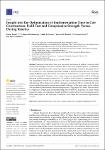Insight into the Optimization of Implementation Time in Cob Construction: Field Test and Compressive Strength Versus Drying Kinetics
| dc.contributor.author | Touati, K | |
| dc.contributor.author | Al Sahmarany, B | |
| dc.contributor.author | Le Guern, M | |
| dc.contributor.author | El Mendili, Y | |
| dc.contributor.author | Streiff, F | |
| dc.contributor.author | Goodhew, S | |
| dc.date.accessioned | 2023-07-27T19:54:06Z | |
| dc.date.available | 2023-07-27T19:54:06Z | |
| dc.date.issued | 2023-09-01 | |
| dc.identifier.issn | 2673-4117 | |
| dc.identifier.issn | 2673-4117 | |
| dc.identifier.uri | https://pearl.plymouth.ac.uk/handle/10026.1/21081 | |
| dc.description.abstract |
Mastering construction times is of paramount importance in making vernacular earth construction techniques attractive to modern clients. The work presented here is a contribution towards the optimization of the construction time of cob buildings. Therefore, this paper follows the evolution of a cob’s mechanical properties during its drying process in the case of a double-walling CobBauge system. Laboratory tests and in situ measurements were performed, and further results were described. Volumetric water content sensors were immersed in the walls of a CobBauge prototype building during its construction. The evolution of the cob layer’s compressive strength and Clegg Impact Value (CIV) as a function of its water content has been experimentally studied and discussed. These studies showed that compressive strength and CIV are correlated with water content, and both properties decrease exponentially with time. In this study, a new tool to evaluate cob’s mechanical performances in situ has been proposed, Clegg Impact Soil Tester. This was linked to compressive strength, and a linear relationship between these two properties was found. Finally, appropriate values of compressive strength and CIV to satisfy before formwork stripping and re-lifting were proposed. For this study’s conditions, these values are reached after approximately 27 days. | |
| dc.format.extent | 2075-2089 | |
| dc.language | en | |
| dc.publisher | MDPI AG | |
| dc.subject | 4005 Civil Engineering | |
| dc.subject | 40 Engineering | |
| dc.subject | 33 Built Environment and Design | |
| dc.subject | 3302 Building | |
| dc.subject | 11 Sustainable Cities and Communities | |
| dc.title | Insight into the Optimization of Implementation Time in Cob Construction: Field Test and Compressive Strength Versus Drying Kinetics | |
| dc.type | journal-article | |
| dc.type | Journal Article | |
| plymouth.issue | 3 | |
| plymouth.volume | 4 | |
| plymouth.publisher-url | http://dx.doi.org/10.3390/eng4030117 | |
| plymouth.publication-status | Published online | |
| plymouth.journal | Eng | |
| dc.identifier.doi | 10.3390/eng4030117 | |
| plymouth.organisational-group | |Plymouth | |
| plymouth.organisational-group | |Plymouth|Faculty of Arts, Humanities and Business | |
| plymouth.organisational-group | |Plymouth|Faculty of Arts, Humanities and Business|School of Art, Design and Architecture | |
| plymouth.organisational-group | |Plymouth|REF 2021 Researchers by UoA | |
| plymouth.organisational-group | |Plymouth|Users by role | |
| plymouth.organisational-group | |Plymouth|Users by role|Academics | |
| plymouth.organisational-group | |Plymouth|REF 2021 Researchers by UoA|UoA13 Architecture, Built Environment and Planning | |
| dcterms.dateAccepted | 2023-07-19 | |
| dc.date.updated | 2023-07-27T19:53:56Z | |
| dc.rights.embargodate | 2023-7-29 | |
| dc.identifier.eissn | 2673-4117 | |
| dc.rights.embargoperiod | forever | |
| rioxxterms.versionofrecord | 10.3390/eng4030117 |


